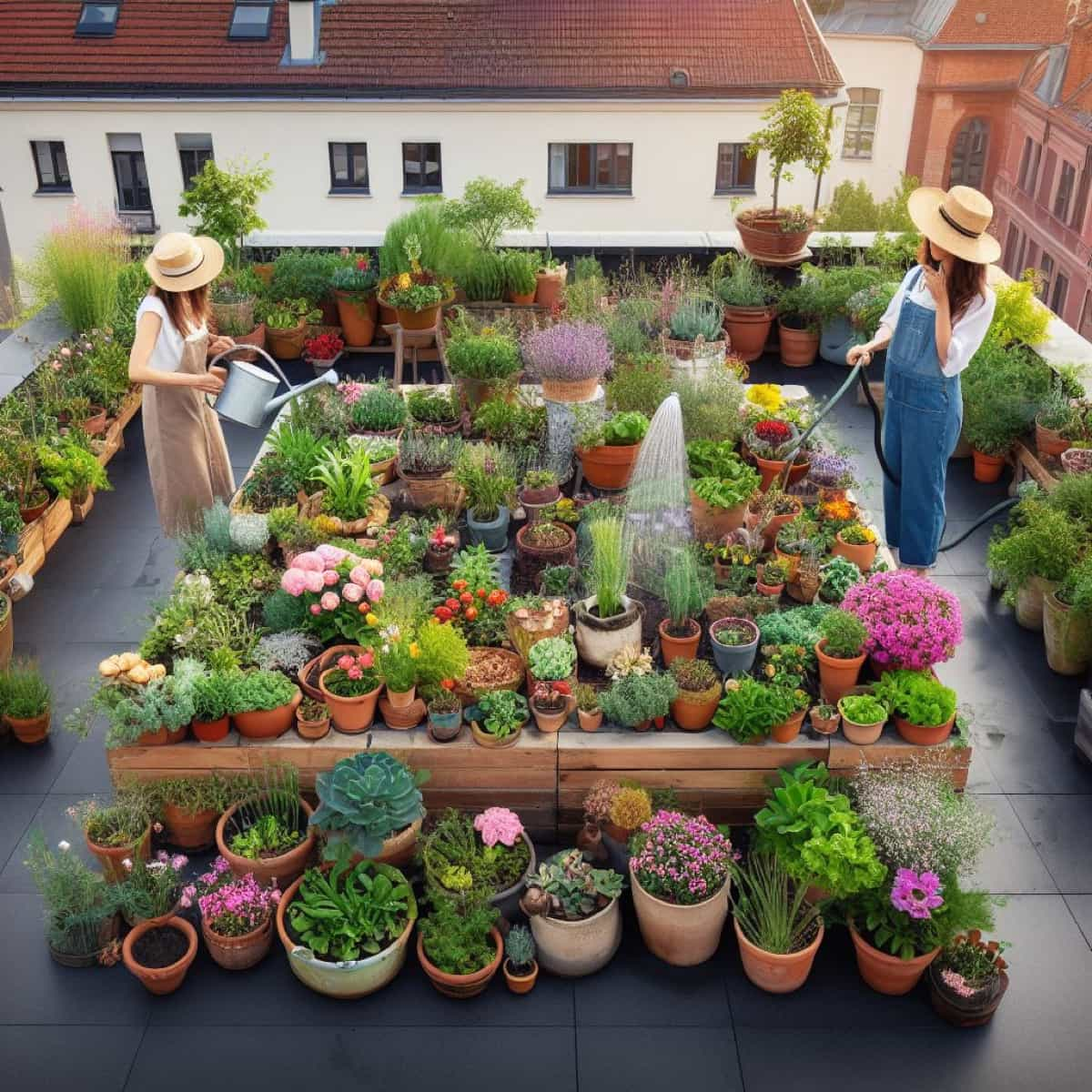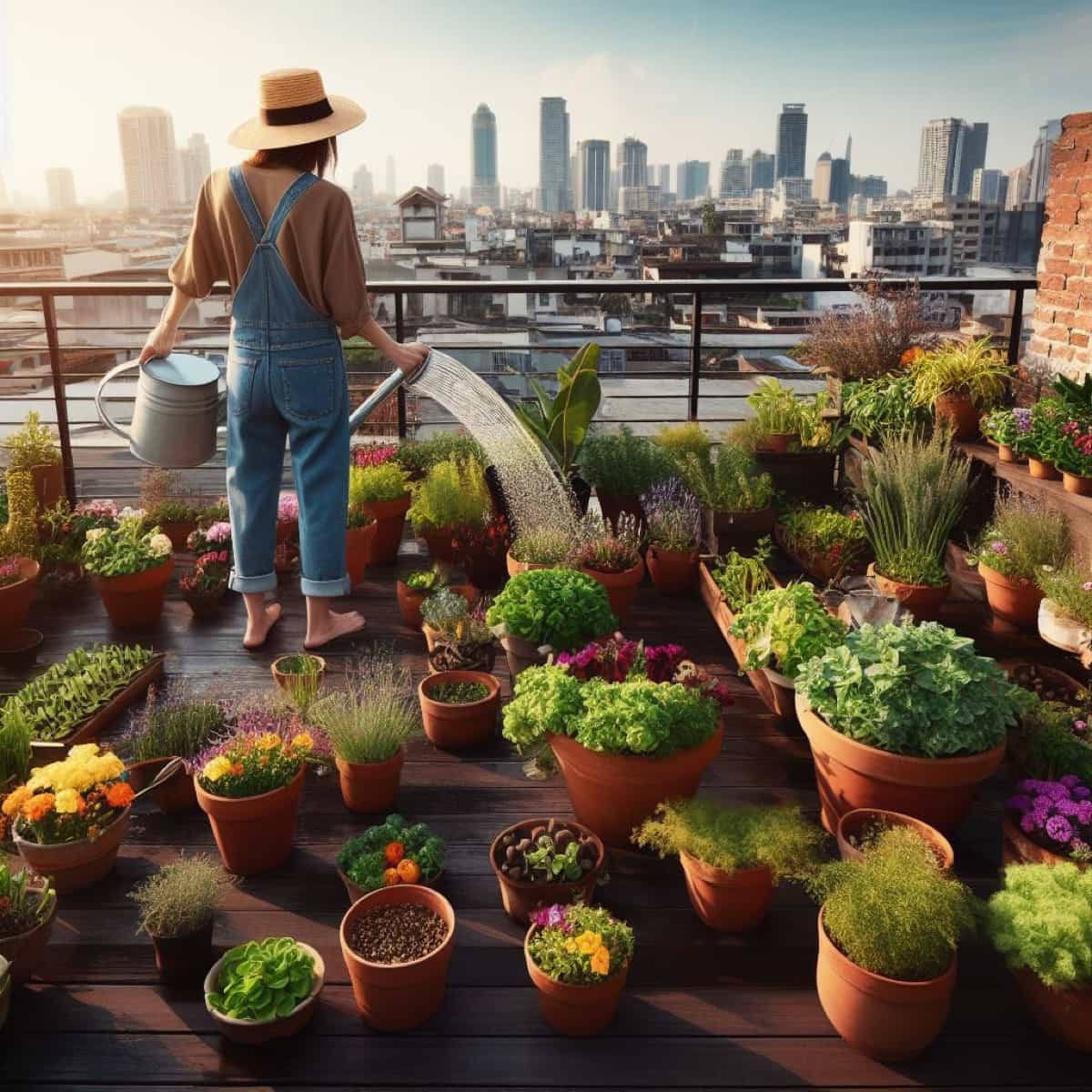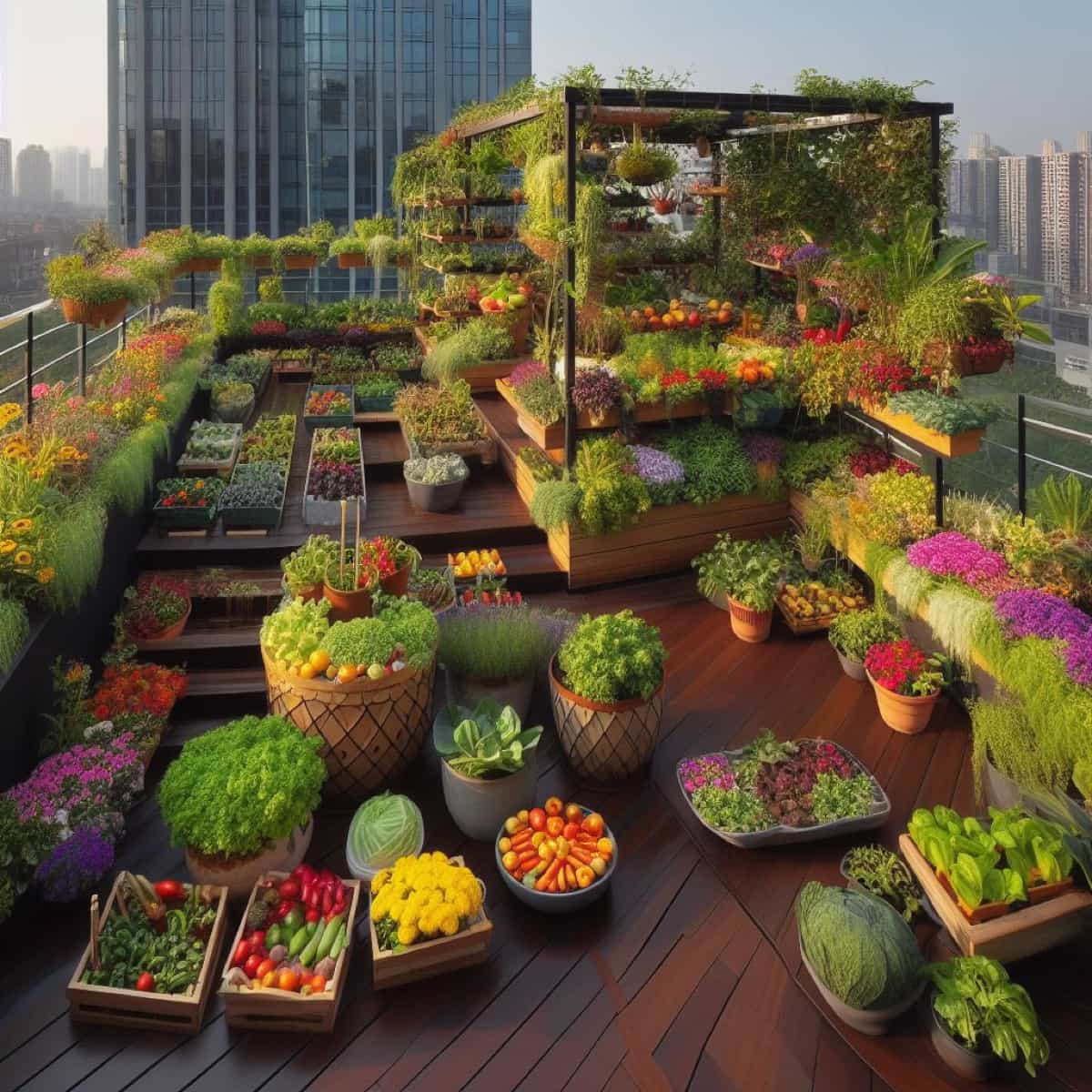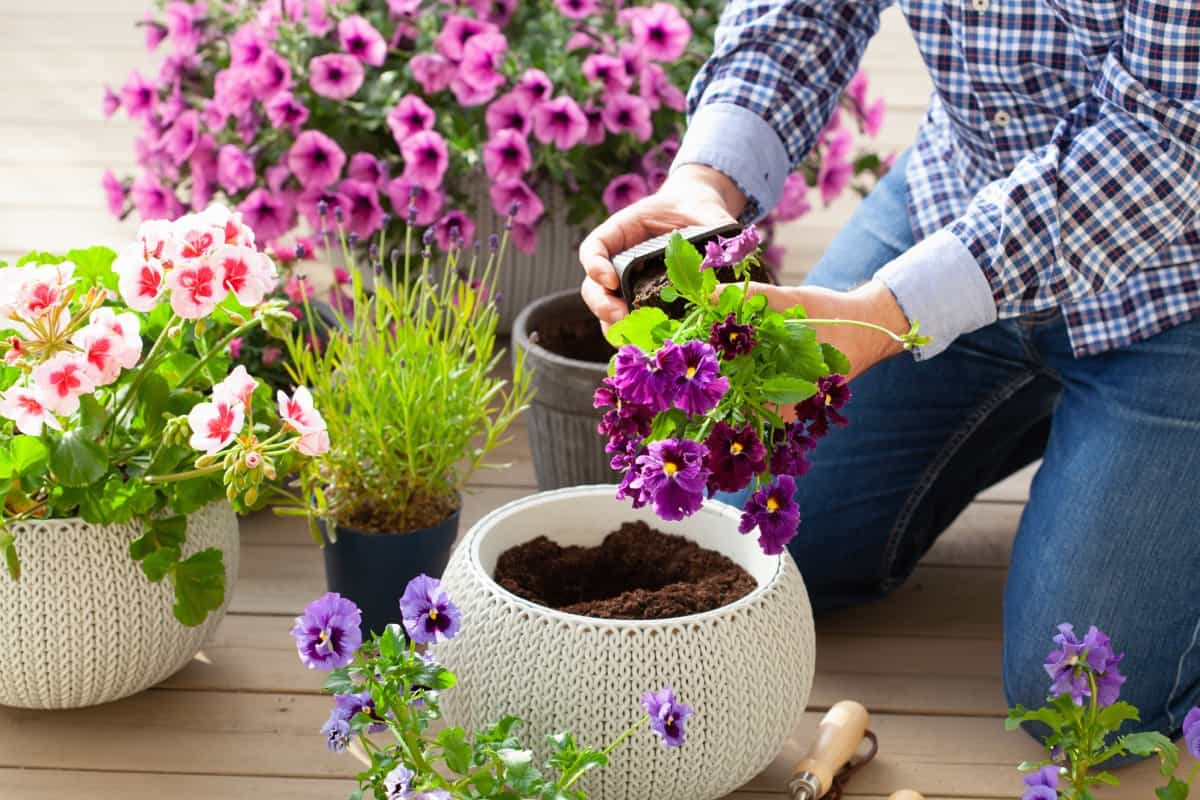Terrace gardening is gaining popularity in Indian cities. It involves creating gardens on rooftops, balconies, or residential and commercial building terraces. Terrace garden setup cost in India primarily depends on various factors, such as the size of your terrace, the type of plants you choose, and the materials used for containers and infrastructure. Various types of terrace gardening can be practiced, depending on the available space and individual preferences.

One of the key reasons for the importance of terrace gardening in Indian cities is its contribution to environmental sustainability. In densely populated cities, where green spaces are limited, terrace gardens provide a much-needed respite by improving air quality and reducing pollution. One of the key benefits of terrace gardening is its positive impact on air quality. They can help reduce pollution levels by filtering harmful pollutants from the surrounding environment.
Moreover, terrace gardening promotes biodiversity by providing habitats for beneficial insects. These green havens offer refuge to wildlife species often displaced due to urban development. In addition to its environmental benefits, terrace gardening also offers economic viability. It allows individuals to grow organic produce such as vegetables, herbs, fruits, and flowers at minimal costs. This not only ensures access to fresh and healthy food but also reduces expenses on grocery bills.
Historical Background of Terrace Gardening in India
Terrace gardening is not a new concept in India. Cultivating plants on rooftops has been prevalent across various regions and cultures throughout Indian history. The idea behind terrace gardening was to create beautiful spaces and efficiently use limited land resources in densely populated cities.
In case you missed it: 12 Common Problems with Terrace Container Gardens: Prevention, Treatment, and Solutions

With space constraints, people turned to their rooftops as an opportunity to grow plants and vegetables. Over time, terrace gardening became more than just a practical solution; it became an art form. Different regions developed unique styles and techniques based on climate, local flora, and cultural preferences. There are many creative ideas for terrace gardening at Home in India that will enhance your living space and contribute to a greener future for our cities.
Benefits of Terrace Gardening in Indian Cities
Terrace gardening in Indian cities brings with it a multitude of benefits that go beyond just beautifying the space. One of the significant advantages is its positive impact on the environment. Terrace gardens contribute to air purification and noise reduction by creating mini-ecosystems on rooftops. Terrace gardening in Indian cities has gained significant popularity in recent years. People are embracing this green trend to make the most of limited urban spaces and reconnect with nature.
Various terrace gardening techniques can be implemented, depending on individuals’ specific needs and preferences. Moreover, terrace gardening helps combat the urban heat island effect by providing natural insulation to buildings. The green cover on rooftops reduces surface temperatures, thus lowering energy consumption for cooling purposes. This saves money, minimizes reliance on fossil fuels, and reduces greenhouse gas emissions.
Environmental Impact of Terrace Gardening in Indian Cities
Terrace gardening in Indian cities is not just a trendy hobby; it has far-reaching environmental benefits that cannot be overlooked. One of the most significant impacts of terrace gardening is its ability to combat air pollution. However, by converting rooftops into green spaces, we can create natural filters that absorb carbon dioxide and release fresh oxygen into the atmosphere.
Moreover, terrace gardens act as excellent insulation for buildings, reducing energy consumption and promoting sustainability. The rooftop vegetation helps regulate temperatures by providing shade during hot summers and retaining heat during cold winters. This reduces reliance on air conditioning and heating systems, lowering electricity usage and greenhouse gas emissions.
Another important aspect is water conservation. Urban areas face constant water scarcity due to excessive use and inefficient practices. Terrace gardens offer an opportunity to capture rainwater through innovative techniques like rain barrels or drip irrigation systems. By collecting and reusing rainwater for watering plants, terrace gardeners contribute towards sustainable water management.
Economic Viability of Terrace Gardening in Indian Cities
Terrace gardening in Indian cities contributes to a greener environment and offers various economic benefits. With the rising cost of living and limited space, terrace gardening allows urban dwellers to grow food and save money on grocery expenses. One of the main advantages is that it allows individuals to cultivate fresh organic produce at minimal costs.
In case you missed it: How to Grow Tabasco Peppers from Seeds: At Home, In Pots, Raised Beds, Terraces, and Backyard

By growing vegetables, fruits, and herbs on their rooftops, people can reduce their reliance on store-bought items, often with high price tags. Moreover, homegrown produce eliminates the need for mediators and transportation costs associated with commercial farming. Many urban gardeners sell their surplus harvest at local farmer’s markets or directly to neighbors and restaurants.
This generates extra income, fosters community connections, and promotes sustainable local economies. Furthermore, rooftop gardens create insulation layers that help regulate indoor temperatures naturally. As a result, residents can reduce their electricity bills by relying less on air conditioning during hot summers or heating systems during cold winters.
Social and Community Aspects of Terrace Gardening in Indian Cities
Terrace gardening not only benefits individuals but also positively impacts society as a whole. In Indian cities, terrace gardens have become more than just a hobby; they have become community-driven initiatives that foster social interaction and unity among residents. One of the major social aspects of terrace gardening is its ability to unite people. Neighbors who previously had little interaction now exchange tips, plants, and even harvests from their terrace gardens.
This camaraderie strengthens community bonds and creates a supportive network where knowledge is freely shared. Moreover, terrace gardening can be seen as a means to bridge generational gaps within communities. Older residents with extensive gardening experience pass down their knowledge to younger generations, fostering intergenerational learning and creating opportunities for meaningful connections between age groups.
Terrace gardens also provide an excellent platform for promoting eco-consciousness within communities. Residents organize workshops and awareness campaigns on sustainable practices such as composting, rainwater harvesting, and organic pest control. These activities not only help in preserving the environment but also educate individuals about their role in sustainability.
Challenges and Constraints Faced by Terrace Gardeners in Indian Cities
Terrace gardening has gained popularity in Indian cities due to its numerous benefits. However, it is not without its challenges and constraints. One of the major challenges faced by terrace gardeners is limited space. City dwellers often have small balconies or terraces, making it difficult to create a full-fledged garden. Another challenge is the lack of proper sunlight and ventilation.
Many buildings in Indian cities are closely packed together, resulting in shaded areas that receive minimal sunlight throughout the day. This can hinder plant growth and limit the types of plants grown on a terrace. Water scarcity is another constraint faced by terrace gardeners. With water being a precious resource, it becomes essential for gardeners to find innovative ways to conserve water while ensuring their plants receive adequate hydration.
In case you missed it: How to Grow Ghost Peppers from Seed: At Home, in Pots, Raised Beds, Terrace, and Backyard

Pests and diseases pose yet another challenge for terrace gardeners. Urban environments are breeding grounds for pests like aphids, mealybugs, and whiteflies, which can damage crops if not controlled effectively. Additionally, pollution from vehicles and industries can negatively impact plant health.
Success Stories and Case Studies of Terrace Gardening in Indian Cities
Terrace gardening has gained popularity in Indian cities, with numerous success stories and inspiring case studies showcasing the transformative power of this green revolution. One such story is that of Mr. Sharma, a resident of Delhi, who converted his barren terrace into a flourishing garden filled with vibrant flowers and organic vegetables. Not only did it enhance the aesthetics of his Home, but it also provided him with fresh produce right at his doorstep.
In Chennai, Mrs. Rao started her rooftop farm, where she cultivated a variety of fruits and vegetables using innovative techniques like vertical gardening and hydroponics. Her initiative helped her family save money on grocery bills and inspired her neighbors to follow suit.
These success stories are just a glimpse into the immense potential terrace gardening holds for urban dwellers across India. With proper knowledge, dedication, and innovation, anyone can create a green oasis amidst the concrete jungle. Despite its many advantages, terrace gardening has challenges, such as limited space availability and a lack of awareness among city dwellers about suitable planting techniques.
Techniques and Methods for Setting up a Terrace Garden in Indian Cities
Setting up a terrace garden in Indian cities requires careful planning of the right techniques and methods. Assess the available space on your terrace and determine its weight-bearing capacity. It is crucial to ensure that your terrace can support the weight of soil, plants, containers, and other gardening equipment. Next, choose suitable containers for your plants. Opt for lightweight options like plastic or fiberglass pots, as they are easier to move around and don’t add unnecessary weight to your terrace.
When selecting soil, use a well-draining mix that retains moisture. You can purchase ready-made potting mixes or create one by appropriately mixing compost, cocopeat, vermicompost, and sand. Ensure proper irrigation by installing an efficient watering system such as drip irrigation or self-watering planters. These methods save water and provide consistent moisture levels for healthy plant growth.
Consider vertical gardening techniques such as trellises or hanging baskets to maximize space utilization. This allows you to grow more plants without taking up excessive horizontal space. Choose plants suited for rooftop conditions like strong sunlight exposure, wind resistance, and limited access to natural rainfall. Some popular choices include succulents, herbs (like Mint and Coriander), flowering annuals (such as Marigolds), vegetables (like Tomatoes or Peppers), and even small fruit trees (such as citrus).
In case you missed it: Tips for Using Terracotta Pots in Your Garden: Benefits and Ideas for Beginners

Suitable Plants and Crops for Terrace Gardening in Indian Cities
| Herbs | Basil, Mint, Coriander, and Curry leaves are commonly grown herbs that thrive well in pots or containers. |
| Leafy Greens | Spinach, Lettuce, Kale, and Fenugreek can be easily grown on terraces. |
| Vegetables | Terrace garden vegetables list in India- Tomatoes, Peppers, Radishes, Carrots, and Beans. |
| Fruits | Dwarf varieties of fruits like Strawberries and citrus trees can be successfully cultivated on terraces properly. |
| Medicinal Plants | Aloe Vera, Tulsi (Holy Basil), and Neem tree saplings have immense health benefits, making them ideal additions to any terrace garden. |
Maintenance and Care Tips for Terrace Gardens in Indian Cities
Maintaining a terrace garden in Indian cities requires regular care and attention to ensure health and productivity. Watering is crucial for the well-being of plants in a terrace garden. Ensure you water them adequately, especially during hot summer months. Use drip irrigation systems or watering cans to provide targeted hydration while minimizing water wastage. It’s important to monitor soil quality regularly. Check for signs of nutrient deficiency or pH imbalance, and amend the soil accordingly by adding organic compost or fertilizers suitable for terrace gardening.
Pruning plays an integral role in maintaining healthy plants. Regularly trim overgrown branches, remove dead leaves, and shape plants according to their growth patterns. This promotes plant health and enhances the aesthetic appeal of your terrace garden. Pest control is another critical aspect of maintenance. Look for common pests such as aphids or mealybugs, and take immediate action using organic pest control methods.
Regular weeding is necessary to prevent unwanted competition from invasive weeds that steal nutrients from your desired plants. Spend some time each week removing any unwanted vegetation from your terrace garden beds. Maintain proper ventilation in your terrace garden by ensuring adequate spacing between plants and allowing air circulation around them. This helps prevent fungal diseases caused by damp conditions and encourages healthier growth overall.
Health Benefits of Engaging in Terrace Gardening in Indian Cities
Engaging in terrace gardening in Indian cities brings beauty and greenery to our surroundings and offers numerous health benefits. The fresh air surrounding your terrace garden can positively affect your respiratory system. Plants release oxygen through photosynthesis, improving air quality and reducing pollution levels.
Additionally, spending time amidst plants has lowered stress levels and improved mental well-being. Growing fruits, vegetables, and herbs on your terrace allow you to consume fresh produce free from harmful pesticides or chemicals commonly found in store-bought varieties. This promotes a healthier diet rich in nutrients essential for overall well-being.
In case you missed it: How to Grow Broccoli in Pots in India: at Home, on the Terrace, in the Backyard and Balcony

Future Prospects and Trends of Terrace Gardening in Indian Cities
Terrace gardening in Indian cities has steadily increased in popularity, and its prospects look promising. As more people become aware of terrace gardens’ environmental benefits and economic viability, this trend is only expected to grow. With advancements in irrigation systems, soil sensors, and automation tools, maintaining a thriving garden on your rooftop will become even easier.
Additionally, there is a growing interest in organic farming practices among urban dwellers. As people prioritize healthy eating and sustainable living, terrace gardens provide an excellent opportunity to grow fresh fruits, vegetables, and herbs without harmful pesticides or chemicals.
Another exciting prospect for terrace gardening lies in community initiatives. Many housing societies are joining to create shared green spaces on their rooftops. This fosters community and allows for larger-scale cultivation where members can share resources and knowledge. Vertical gardens maximize space utilization by growing plants vertically along walls or trellises. This technique adds aesthetic appeal and offers better airflow and sunlight exposure for healthier plant growth.
Conclusion
Terrace gardening is not just a passing trend but a sustainable solution with immense potential for transforming our urban spaces. It brings multiple benefits for both the urban dwellers and the environment. While starting your terrace garden may have its fair share of challenges, such as limited space and lack of expertise, these obstacles can be overcome with proper planning and knowledge-sharing platforms. The success stories from various Indian cities serve as an inspiration to take up this green initiative and contribute towards making our cities more livable.
- Where to Place Indoor Plants in Your Home
- How to Grow Tomatoes Organically at Home: A Comprehensive Guide
- Organic Gardening on a Budget: Low-Cost Methods and Materials
- Gongura Seed Germination and Planting Methods
- Cabbage Seed Germination and Selection
- Broccoli Seed Germination and Selection
- Asparagus Seed Germination and Variety Selection
- Seasonal Flower Gardening: Best Practices for Spring, Summer, Fall, and Winter
- How to Grow Hibiscus from Flower
- Plantation Ideas for Home Decoration: A Beginners Guide
- Flower Garden Designs and Layouts for Beginners
- Planting and Spacing Techniques in Papaya: A Beginner’s Guide
- Growing Gold: Essential Techniques for Planting Pineapples
- How to Make Kalanchoe Plant Bushy: Home Remedies and Solutions
- 11 Reasons Why Your Gardenia is Not Blooming: Home Remedies and Solutions
- Eco Elegance: The Guide to Designing a Drought-Tolerant Landscape
- Gardening on a Slope: Strategies for Hillside Landscaping
- Nourish and Flourish: Top Organic Mulches for Thriving House Plants
- Everything You Want to Know about Indian Mogra Flower: Discover Uses and Growing
- Green Thumb Success: Expert Tips for Cultivating Greenhouse Pumpkins All Year Round
- Maximize Growth & Flavor: The Ultimate Guide to Companion Planting in Herb Gardens
- How to Control Rhododendron Problems Naturally: Home Remedies and Organic Ways to Fix Them
- Natural Magic: The Remarkable Benefits of Cinnamon for Plants
- Best Steps to Revive Dying Tulip with Natural and Organic Treatment
- 10 Reasons Why Your Angel Trumpet is Not Blooming: Remedies and Treatment
- How to Fix Periwinkle Leaf and Flower-Related Problems: Natural Remedies and Solutions
- How to Fix Zinnias Leaf and Flower Problems: Discover Natural and Home Remedies
- Organic Steps to Induce Lemon Tree Flowers: A Comprehensive Guide
- Bloom Booster: Crafting the Perfect Homemade Bougainvillea Fertilizer
- Optimizing Growth: A Guide to Applying NPK Fertilizer for Potted Plants
- 10 Best Homemade Fertilizers for Rubber Plant: DIY Recipes and Application Method
- How to Boost Female Pumpkin Flowers: Effective Steps for More Flowers and High Yields
- Transform Your Indoor Garden: Top Benefits of Pink Salt for Houseplants
- 10 Best Homemade Fertilizers for Peacock Plants (Calathea): Easy DIY Guide
- Unlock Blooms: 9 Reasons Why Your Potted Chrysanthemum is Not Blooming
- 8 Reasons Why Your Potted Hibiscus is Not Blooming: Fix it with Simple Solutions